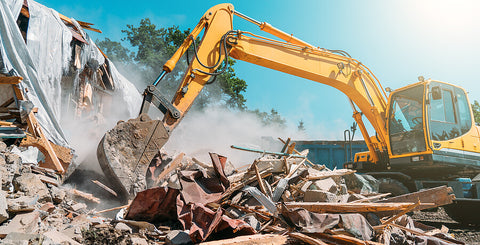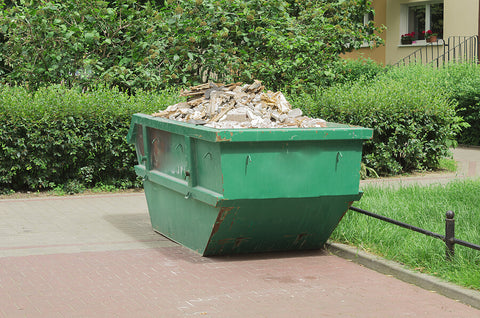When carrying out any type of building work, construction waste is generated. Correctly managing this waste is a legal requirement and helps manage construction costs.
What is construction and demolition waste?
Construction and demolition waste is classed as any type of debris leftover from the construction process. For example, materials from a house renovation, building site, or larger demolition project.
The waste is classified into different categories and comes with a unique code, as well as a hazardous or non-hazardous label.
Some types of common construction waste include:
- Insulation and asbestos materials
- Concrete, bricks, tiles and ceramics
- Wood, glass and plastic
- Bituminous mixtures, coal tar and tar
- Metallic waste, including cable
- Soil, contaminated soil, stones and dredging spoil
- Cement
- Paints and varnishes
- Adhesives and sealants
Sometimes known as builders waste, construction waste cannot be put into regular waste and recycling bins as it may damage equipment at waste management facilities. It requires specialist handling and sites may be issued a fine if they do not dispose of construction waste correctly.
How does construction waste affect the environment?
In many large cities, construction and demolition waste is the source of the largest waste stream. Large-scale building projects generate huge amount of debris – sometimes as much as 30% of the total weight of building materials delivered to building site will end up as waste.
In 2018, it was estimated that around 62% of the UK’s total waste came from the construction, demolition and excavation industry. Meanwhile, around 13% of building materials delivered to a site go straight to waste, without having ever been used.
With the majority of construction waste ending up in landfill due to its hazardous nature rendering it unrecyclable, the carbon footprint of building debris is dramatically high.
Landfill sites not only scar the local environment and damage surrounding ecosystems, but overtime they also release powerful chemicals into the atmosphere and ground soil.
How to reduce construction waste

With a growing focus on the climate emergency, coupled with supply chain issues, many companies are looking at how to reduce their construction waste and make the most of building materials.
Having a clear set of guidelines before beginning a construction or demolition project helps to stay on top of site waste.
Construction waste management plans are a good way to streamline the disposal process and ensure minimal debris is being discarded. Also known as site waste management plans (SWMP), they usually outline who will be responsible for the resource management, what types of waste will be generated, how the waste will be managed, which contractors will be used, and how the quantity of waste generated will be measured.
When carrying a out a project in England with an estimated construction cost of over £300,000, a SWMP must be used. However, many people working on smaller projects also choose to have a construction waste management plan in order to follow good industry practice.
By analysing waste production and material usage, SWMP help to protect the environment. Less building debris goes to landfill and a greater number of recycled materials are used in the project. Other environmental hazards such as fly-tipping are also reduced, and less energy will be used when disposing of the waste.
Better storage and handling of construction waste also helps to save money, while reusing materials on site can minimise disposal costs. A construction waste wheelie bin helps building sites become more efficient, saving a project time and money. They are a great alternative to hiring a skip and the wheels mean it can be moved around any site. Sort the construction waste into different categories, making it easy to reuse materials or dispose of hazardous waste if necessary.
Construction waste removal

If construction waste cannot be reduced, reused, or recycled by building sites directly, then it must be disposed of appropriately by an external party.
When searching for a construction waste disposal service near you, one of the most important things to consider is their commitment to the environment. Ask about a company’s construction waste recycling practices and how they reuse building waste materials.
Building sites also need to ensure that the waste management company is properly licensed and dispose of the waste at an official site. If not, construction companies may be liable to pay the landfill tax.
Construction companies must provide a waste transfer note of all the construction debris they are giving to the waste management company. This is when the aforementioned codes and hazardous status must be used, as well as other information including where the waste was produced, the process that generated the waste, names of the substances, and more.
Wheelie Bin Solutions has a comprehensive service of disposal units, including construction site waste bins. These can used at a commercial and personal level, and are made from sturdy and robust materials in a variety of colours.








Craig Pryce
With over 17 years of experience in the waste and recycling industry, Craig is passionate about making recycling easier and reducing the negative impact of litter. He has been the managing director of Wheelie Bin Solutions (WBS) since January 2016, and prides the company on his expert knowledge, top-quality products, and customer service. His proudest moment was when WBS supported the 2012 Olympic Games, working in partnership with Contenur UK to supply over 9000 bin containers to all Olympic venues. Craig is always keen to share his knowledge, so whether you need advice about the benefits of a wheelie bin lock, or ideas for alternative uses for your wheelie bin, Craig will ensure your recycling and waste disposal habits are gold medal worthy.